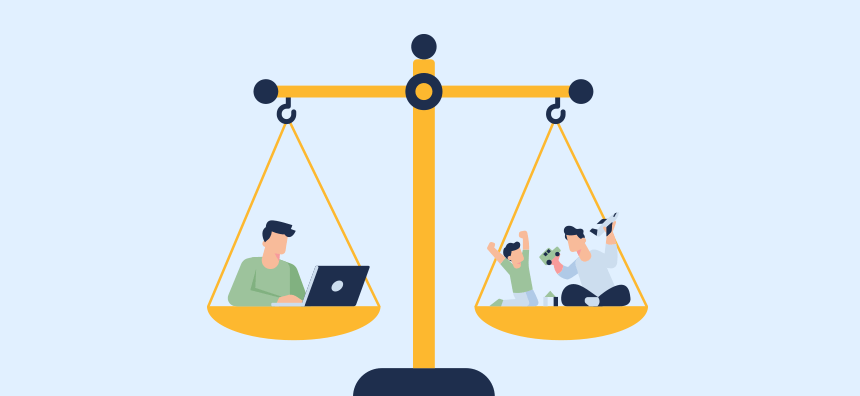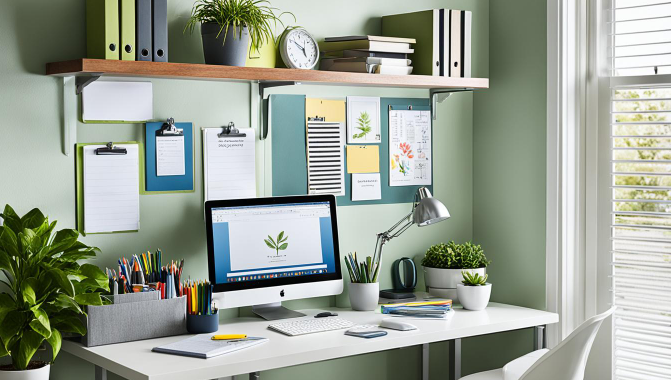Working from home mixes work and fun in tricky ways. Strengthening self-discipline becomes a key part of staying productive when your house is full of both work and personal responsibilities. We need good plans to keep things efficient at home and avoid time constraints that can negatively affect our progress. Here, we share seven top tips to improve how you accomplish tasks so your entire day feels more productive and balanced.
A study by Robert Half showed 73% of people work better at home by working in short bursts. This “windowed work” helps with tough tasks and keeps you sharp. Taking breaks, like meetings, also helps keep you energized.
Setting an alarm for the workday end makes work and personal time distinct. Also, people usually finish five tasks daily. This makes daily goals more doable and boosts productivity.
For those working alone, knowing you do best in the early afternoon helps. Use time-blocking to focus on one task at a time. A special work area can boost your focus and work-from-home success.
Following these steps, your home life can improve. It helps keep your work productive and balanced. This way, you can do well and stay happy while working from home.
Many people do their best work early in the afternoon or first thing in the morning, depending on their natural “work mode.” Using time effectively with time-blocking lets you stay focused and stay ahead of your responsibilities.
Understand the Importance of Effective Time Management Strategies for Remote Workers
Setting up a work routine at home boosts productivity and helps maintain a healthy balance. Using a flexible schedule also improves teamwork while preventing missed deadlines and rushed, time-bound tasks.
Create a Daily Schedule
A strong daily schedule supports focus and productivity. You can use a planner or digital tools like Google Calendar to map out the day, set reminders, schedule phone calls, and avoid wasting valuable time. A solid plan protects your energy for high priority and low priority tasks alike.
Collaborate with Partners or Roommates in Free Time
Planning with those you live with is key. Using shared calendars or chat apps like Slack helps everyone get along. It helps everyone know what’s happening. This keeps things calm and makes work flow better.
Adopt the “Windowed Work” Approach
“Windowed work” means dividing your day for work and personal things. It boosts productivity for 73% of people. “Windowed work” means dividing your day into work periods and personal moments. It can boost motivation and give you enough time for essential activities, such as cooking, making a meal plan, updating your grocery list, or paying pay bills without stress.
Designate Specific Workspaces
Working from home is now common. It’s important to have specific workspaces. A Stanford University survey found that 42% of Americans work from home full-time. Before the pandemic, it was just 2%.
Separate Areas for Work and Leisure
It’s key to keep work and leisure areas separate. This balance is crucial for a productive life. Having a focused area for work is essential. It helps keep a clear line between work and rest. For tips on organizing your home office, visit this guide.
Consistent Work Environment
Having a consistent place to work is key for productivity. The Bureau of Labor Statistics says 29% of Americans can work from home. This number increased a lot due to COVID-19. A well-set home office helps you stay focused. For more on creating a workspace, see this helpful resource.
A dedicated workspace boosts efficiency. It shows the value of organizing your office at home. This approach improves time management. It also makes work comfortable and productive.
Leverage Productivity Apps To Overcome Poor Time Management
Project management software can greatly improve how we work from home. 78% of remote workers find they do more at home. It is important to use tools that help with task management and keeping things organized.
Project Management Tools
Tools like Trello, WeekPlan, and Monday.com are great for managing projects. They let teams assign manageable tasks and keep track of deadlines. This keeps work flowing smoothly and ensures projects finish on time.
Time Tracking Software
Knowing how we spend our time at work is key. Toggl, RescueTime, and Clockify help track time spent on tasks. A study says 63% of remote workers need clear goals to stay organized. These tools help people stay focused and manage their time better.
Break Reminder Applications
Taking breaks is important for staying productive. A Toggl survey found that 79% of workers are more motivated after a break. Apps like Stand Up!, Break Timer, and Stretchly remind people to rest. This helps with both health and work performance.
Dress for Success
Dressing like you’re going to an office can really help when you work from home. It can make your day better. Wearing work clothes regularly boosts motivation and productivity.
Maintain a Morning Routine
A good early morning routine is key to productivity. It should include waking up at the same time and getting dressed for work. These actions get you ready for the day and tell your brain it’s work time.
Psychological Benefits of Dressing Up
Dressing well can make you feel better about yourself. Wearing work clothes can make you feel more professional. It also keeps you disciplined and feeling normal.
For online meetings, dress like you would for an office. This shows you’re serious and keeps you focused. Wearing blue light glasses can help with eye strain from screens.
Take Breaks as Seriously as Meetings
Adapting to homework brings the need for regular breaks to light. These breaks are key for health and keeping up work. Interestingly, 30% of home workers feel “highly stressed”, versus 25% in the office. Planned breaks lower this stress.
Schedule Regular Breaks
Though it seems simple, planning breaks has science support. A study from the University of Illinois suggests breaks every hour. Inc. Magazine says to take them every 60-90 minutes. The Pomodoro Technique breaks up the day into 25-minute parts with short breaks. And after four parts, you take a 15-20 minute break. Treating break time like meetings boosts work-life balance.
Engage in Relaxing Activities
Relaxing activities during breaks lower stress and boost energy. Breaks help with focus and reducing stress. Stretch, walk, meditate, listen to music, or enjoy a hobby during these times. Less screen time during breaks makes them even better.
Communicate Break Times with Coworkers
Telling coworkers when you break builds respect and understanding. It makes sure everyone honors breaks. These breaks, tailored to needs and work, increase productivity and motivation. Clearly share when you’ll take breaks to keep work flowing smoothly.
Minimize Social Media Distractions
Today, avoiding digital distractions is key. A lot of home workers find social media and emails very distracting. There are many ways to stay away from the draw of these platforms.
To stay focused, log out of social sites when you’re working. Also, delete browser shortcuts and use private browsing to avoid auto logins. This keeps your work time focused.
Android and iOS users have help too. Android lets you limit app time each day. iOS has Screen Time to control how much you use apps. These help make a workspace with no distractions.
The Pomodoro Technique boosts productivity with 25-minute work chunks and short breaks. Or, try working 52 minutes and breaking for 17. These methods help keep focus high.
Turning on “Do Not Disturb” on your phone helps too. It blocks work-time disruptions. Also, creating scheduled breaks. About 75% of remote workers say breaks help them focus better.
Michael Page suggests balancing work and home life is crucial. It boosts your efficiency and makes home life better. Mixing these strategies can make remote work more focused and manageable.
Be Open with Your Manager About Work Schedules
Talking openly with your manager about work times is key. It’s important to agree on hours and availability. This ensures a good balance between work and life.
Establish Clear Work Hours
Having set work hours is important when working remotely. A study shows 73% of people like a mix of home and office work. Sharing your schedule with your manager helps set expectations and keeps work from taking over your life.
This also makes companies better. They see a 15% jump in how much work gets done when they offer flexible schedules.
Communicate Personal Constraints
It’s key to talk about what time you can’t work. Sharing your limits makes it easier to fit work into your life. A study found 91% of folks felt less stressed about commuting with a flexible schedule.
Maintain Transparency
Being open about your schedule and limits builds trust. A survey found 64% of workers think a flexible schedule makes life better. Another study showed companies keep more employees when they offer flexible scheduling. Openness helps you and your company do well.
Set Boundaries to Separate Work and Personal Life

It’s key to have clear work-life boundaries for good remote work habits. With 42% of workers in the U.S. working from home, it’s important to keep work and personal time separate. Many work longer hours and feel they must always be on. This can lead to feeling burned out and less productive.
Begin by using alarms to mark the end of your workday. Turn off work-related notifications too. This keeps work from taking over your free time. Also, have a set place to work at home. This helps keep your work life separate.
Breaks are a must, not just a nice to have. Studies show that taking short breaks can make you 20% more productive. Saying “no” helps avoid tiredness and burnout. Make sure to look after yourself and make time for fun and rest.
About 77% of remote workers do better when they have clear boundaries. Without them, there’s a 48% chance of feeling very stressed. This can make you less productive. So, setting clear work times and keeping work and life separate are key.
Time Management Tips for Working from Home
Working from home calls for special plans. Distractions and no set work hours make it tough. A disciplined plan is key for doing well.
First, set up a personal work schedule. Without a regular office schedule, you need to choose your work times. Dressing like you’re going to the office can make you 30% more motivated.
Next, limit distractions. Use things like noise-canceling headphones and keep your workspace separate. Turning off your phone’s notifications can cut distractions by 70%.
Focusing on the most important tasks each day helps. This stops you from feeling too swamped and keeps you productive. Studies show doing one task at a time reduces errors and ups efficiency.
Making to-do lists that are doable is key. But, only 25% of people working from home manage this. Setting aside specific times for completed tasks can help manage this better, making you less stressed.
Tools like software for managing projects and lists help a lot. They make tracking your progress easier. Using them can boost your productivity by 25%.
It’s crucial to keep work and personal time separate. Dressing for work and having your own work space help with this. It makes you more productive by setting clear rules at home.
Taking breaks is also important. Folks who do this work 30% better. Plan your breaks as carefully as your meetings to avoid feeling too tired and to stay sharp.
Prioritize Self-Care and Personal Time
In today’s world, keeping a balance between work and life is vital. It’s especially true when working from home. Understanding how to manage personal time and work is key.
Adequate Sleep
Getting 8 hours of sleep each night can make you more productive. It’s also key for your well-being. Setting a fixed time to end your workday is crucial for this balance.
Good sleep habits are very important for people who work from home. They help you separate work time from rest time.
Family Members and Leisure Time
Taking breaks to spend time with loved ones is very important. It helps you connect with others and manage your time well. Sharing a meal or chatting can make you feel refreshed and more productive.
Mental Health Breaks
Taking breaks is essential for staying focused and energized. Methods like the Pomodoro Technique can keep you productive. They allow rest while keeping work efficiency high.
Activities like hobbies, exercise, and relaxing are key for self-care. By focusing on these, you can work well and live a balanced life. They help maintain your mental health and keep your work-life balance positive.
Identify and Eliminate Time Robbers
It’s about finding what steals your time and fixing it. Track what you do each day. Notice the things that distract you often. Make changes to handle these distractions. Track your day to locate activities that consume valuable time. Remove unnecessary meetings, multitasking, or habits that negatively affect your schedule. Adjust your routine to support focus and save time.
Understanding how you spend time is key. It helps you take back control of your day. This way, you can be more productive.
Track Daily Activities
A deep look at how you spend time can show where you lose it. People often lose up to an hour daily. This really hurts how much they get done.
By watching what you do closely, you learn where time goes. Especially the time not spent on work.
Recognize Distractions
People lose about 2.9 hours in an 8-hour day on other stuff. That’s a lot of lost time! Too many meetings are a big problem for half of workers.
Seeing what distracts you is crucial. Getting rid of these things helps a lot. It’s an important step to being more productive.
Adjust Routine Accordingly
Making changes based on what you find is smart. Successful time management is key. It can mean setting limits, not trying to do too much at once, and just focusing on one thing at a time.
Small shifts can make a big difference. Use the internet less and take breaks that really help. These changes can make you way more efficient at work.
Conclusion: Simple Tips to Manage Your Time Successfully at Home
Working from home is key in today’s flexible work scene. We’ve shared many simple tips for a better remote work-life balance. Setting up a structured schedule helps manage daily tasks and keeps productivity up.
With 71% of US workers happier at home than the 53% in offices, a good routine ensures you can complete specific tasks while still making less time feel more productive. Personal workspaces and tools like Toggl and Everhour boost focus and lower stress. It’s important to care for yourself, build healthy habits, and set work-life boundaries to avoid burnout and stay productive. It’s important to care for yourself and set work-life boundaries to avoid burnout and stay productive.
91% of remote workers appreciate balancing work with family obligations and personal needs. Those who use these tips well will do great—even when juggling house chores and work responsibilities.
Talking clearly with managers about schedules and limits helps everyone. Following these practices and improving your remote-work methods can make working from home great. As Mark Twain famously suggested, tackling your hardest item on the task list first thing can help you stay motivated and get more done with less stress.
Frequently Asked Questions
What are the best strategies for maintaining work-from-home efficiency?
Make a regular plan for every day. Keep work and home life separate. Use tools that help you stay organized.
How can I create a structured work routine?
Plan your day or week in advance. Use calendars that everyone can see. Try breaking your day into work and rest times.
Why is it important to have a dedicated workspace at home?
Having a special work area helps you focus. It makes a clear line between work time and relax time. This makes you more productive.
What productivity apps are useful for remote work?
Use Asana or Trello for managing specific tasks, Toggl for time tracking, and Stretchly for break reminders. These help you stay on track and avoid house chores creeping into work time.
How does dressing up for work influence productivity?
Wearing work clothes at home makes you feel more professional. This helps you manage your time well and stay disciplined.
How should I approach taking breaks during the workday?
Plan short breaks throughout the day. Do something relaxing during these times. Let your team know when you’ll be taking breaks.
What are some effective ways to minimize social media distractions while working from home?
Sign out of social media when working. Remove easy access to these sites. Using incognito mode can also help avoid temptations.
How can I communicate my work schedule with my manager?
Tell your boss your work hours and any limits you have, especially the times you need for uninterrupted work. Be honest about when you do your best work and how you handle routine tasks throughout the day. This helps everyone know what to expect.
What are some tips for maintaining a separation between work and personal life?
Set an alarm to mark the end of your workday. Turn off work alerts after hours. Keep your work stuff separate from your personal space.
How can I prioritize self-care while working from home?
Make sure you sleep enough. Spend time with loved ones and relax. Take breaks to look after your mental health.
What are “time robbers” and how can I eliminate them?
“Time robbers” break your focus. Keep track of what you do each day. Find out what’s distracting you and change your habits.

More Posts
10 Time Allocation Tips for Maximum Productivity
In today's world, managing our time well is key to success and happiness. Studies show managing our time better can help us work better, feel less stressed, and get more done. 


